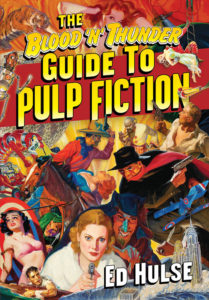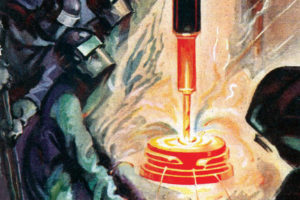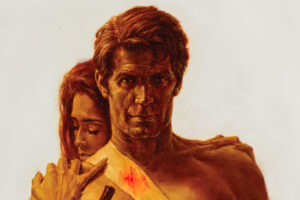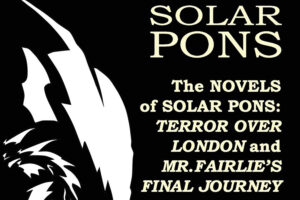 Back in 2013, I did a review on an excellent reference guide to the world of pulps: The Blood ‘n’ Thunder Guide to Pulp Fiction, written by Ed Hulse who runs Murania Press and publishes the excellent Blood ‘n’ Thunder magazine, now as a series of books.
Back in 2013, I did a review on an excellent reference guide to the world of pulps: The Blood ‘n’ Thunder Guide to Pulp Fiction, written by Ed Hulse who runs Murania Press and publishes the excellent Blood ‘n’ Thunder magazine, now as a series of books.
While I gave the work high praises, there were a few problems. The most glaring being the lack of an index. Now in 2018, this has been addressed with a new, second edition of the work. To avoid people having to go back to my old review, here is an updated review for the updated edition. In addition to updates, the book has been expanded, but apparently by using a smaller typeface, the book isn’t that much thicker.
As I had noted in my original post, as a long-time science fiction fan, I obtained many reference books on science fiction. As I got into the world of pulps, I did the same. I felt that as I got more into pulps, such references helped me understand the world of pulps: the authors, editors, and publishers of pulps, the genres and history. While I’m no expert, I think this helps be more knowledgeable about things, something I wish more fans would do themselves. Thus I think this work, among others, should be on the shelf of any self-respecting pulp fan.
The book has several chapters devoted to different pulp magazine genres. Further, the top third of each page is given over to two pulp covers (though in black and white), so we also get to see a lot of great covers.
We first start off with a chapter on Pulp 101. This chapter gives a great overview of the pulp magazines. It explains how pulps came about, and how they developed over the years. It also has some basics on collecting pulps.
Each subsequent chapter focuses on different genres, looking at the pulps that fall within each genre. We get a great overview of each of these magazines, pointing out some of the best stories that appeared in them. Further, we learn a little about the publishers as well as the editors and their editorial decisions, which is important in understanding why they published what they did. We have:
• The Pulp Pantheon: The view by many is that the best early pulp fiction appeared in a handful of magazines, and this chapter focuses on them: Argosy, Blue Book, Adventure, Short Story, and The Popular Magazine, along with several pulps that got merged into them, like All-Story. We first start off with All-Story (which later merged into Argosy), and the works that appeared there such as Edgar Rice Burroughs‘ early works (i.e. Tarzan), some of the ERB clones such as Charles B. Stilson and J.U. Giesy. Then we learn about western author Max Brand, the appearance of Zorro, and early SF classics from A. Merrit and Ray Cummings. Then with the merger with Argosy, we hear about works by Perley Poore Sheehan, H. Bedford-Jones, and others. The popular Peter the Brazen series appears in Argosy. We also hear of further stories by many of the above authors which continued to appear in Argosy before moving on to Adventure.
We learn about the beginning of Talbot Mundy in Adventure and the development of this magazine, then move on to Blue Book. We also learn of the many pulpsters who appeared in Blue Book, including ERB who moved over here from All-Story. Next is Short Story. Then we finish up with The Popular Magazine.
• Western & Adventure: I am not a fan of westerns, but this chapter is a good overview of the genre, then moving into adventure, which I think will have a wider appeal. Many good magazines and stories in this area are pointed out.
• Crime & Mystery: Probably one of the biggest genres in pulp. We start off looking at Street & Smith’s long running Detective Story Magazine. We learn of Johnston McCulley‘s many early characters (The Spider, Thubway Tham, Thunderbolt and others). We move on to the long-running Black Mask. Next up is Flynn’s Weekly, which became Detective Fiction Weekly. This magazine published the works of Erle Stanley Gardner, and then the long running Park Avenue Hunt Club. Popular Publication’s Dime Detective Magazine follows. Other detective magazines are next. Several shorter pulp heroes are mentioned in this chapter, such as Mr. Death, Doctor Coffin, and several of McCulley’s later heroes. Ace Magazines’ long running detective magazines come next, with mentions of Wade Hammond, Lester Dent‘s Lee Nace, and Moon Man. Street & Smith’s Crime Busters is also examined, with its characters such as Norgil, Click Rush, Death Angel, Carrie Cashin, and more. Dan Turner, Hollywood Detective is next, and the chapter rounds out will a look at the various other publishers and their efforts in the area.
• Horror & Fantasy: This chapter starts off looking at magazines like Weird Tales and its imitators. A lot of great stories that appeared in Weird Tales and others are mentioned. Then it moves into the “weird menace” pulps of Popular Publications, such as Dime Mystery, Terror Tales, Horror Stories, and such. It wraps up looking at the similar magazines from other publishers.
• Science Fiction: This chapter starts off with the first pulp devoted to science fiction, Hugo Gernsback‘s Amazing Stories. He lost ownership of this magazine, and so started Science Wonder Stories and Air Wonder Stories. Amazing Stories continued without him, soon owned by Ziff-Davis who put Ray Palmer in charge. He would later start publishing the “Shaver Mystery” stories. While Gernsback did well with his magazines, he eventually had to sell them to Ned Pine‘s Thrilling line, where they became Thrilling Wonder Stories. Thrilling soon added Startling Stories. We also learn a little about Martin Goodman (owner of Timely/Marvel Comics) Red Circle line of SF pulps that mixed in spicy and weird menace elements. Other short lived SF pulps from Munsey, Popular, and Fiction House are looked at next. Then the long running Astounding, first owned by Clayton then Street & Smith, and still lives on today as Analog, a digest magazine.
• War & Aviation: This chapter first looks at the several war pulps, which I don’t find of interest, but would point out that you learn about a long-running character that ran in these named Terence X. O’Leary. Then we move into the various air/aviation pulps. We also learn about the various serial characters that ran in them. With Ace’s Flying Aces, we hear about Donald Keyhoe‘s Captain Philip Strange. Another is Battling Grogan. Flying Aces also had The Griffon and Phineas Pinkham. But Keyhoe’s Richard Knight wasn’t mentioned. We also learn about Dell turning Terence X. O’Leary into a short-lived SF pulp hero. Then we move to Popular and hear about some of their air war series, like The Three Mosquitoes, Smoke Wade, The Red Falcon, and Captain Babyface.
• Pulp Heroes, Part One: This chapter focuses on the Street & Smith pulp characters. We first delve into The Shadow, with a lot of info on him, then move into Doc Savage with lots of info on him. Then we move into the lesser known S&S pulp heroes Nick Carter, Pete Rice, Bill Barnes, The Whisperer, The Skipper, The Avenger, and finally The Wizard. Some of their other pulp characters are actually covered in other chapters. The ones published in Crime Busters appear in the Crime & Mystery chapter, for instance.
• Pulp Heroes, Part Two: This chapter looks at the pulp heroes from other publishers. We start off with Thrilling and looking at The Phantom. Then move on to The Lone Eagle, Dan Fowler, The Black Bat, Captain Future, and then on to their lesser heroes the Green Ghost and Masked Detective. Then Thrilling’s western hero pulps Texas Rangers, Masked Rider, and Hopalong Cassidy are examined. Next we move to Popular Publications and their heroes The Spider, G-8, Operator #5, and then a look at some of their short-lived characters Secret Six, Dusty Ayres, Captain Satan and their villain pulps. Brief mention is made of Captain Combat and Captain Zero, the last original pulp hero. Then we move to Ace and their heroes Secret Agent X, and brief mention of Wade Hammond and Captain Hazzard. Fiction House and their jungle heroes like Ki-Gor and Sheena wrap up the chapter.
• Those Spicy Girls: Obviously this chapter is on the whole “spicy/saucy” genre of pulps. Useful also is to learn about the publishers of these magazines, such as Harry Donenfeld and Frank Armer, who published many of these under a variety of company names such as Trojan, Culture, and Speed. They published Jim Anthony, Super-Detective, but there’s no mention of the character here. This chapter touches also on Hugh Cave‘s The Eel, and pulp heroine Domino Lady.
• Sports & Love: This chapter is on the various sports oriented pulps, including the fight ones, as well as romance. Again, not an area I am interested in, but it does include info on characters such as Robert E. Howard‘s Sailor Steve Costigan.
Then we have four appendixes. First off is a great list of notable reference books on the pulps. Those I have been the subjects of previous posts or will be in future posts. Next is a recommendation on building a pulp magazine collection. Then we get a list of publishers focused on pulp reprints. While it’s a great list, it still leaves off smaller presses like Pulpville Press and BEB Books. Finally, we have a list of must-have pulp fiction anthologies, for those wanting to read classic pulp fiction.
The previous version was pretty good, marred by a couple of mistakes. This one addresses the major ones, making it even better. There are still a few missing points, but those are minor and to be expected in a major work like this. I thought the first edition was a must-have book for any serious pulp fan, and this one is even more so. If you want to have a better understanding of pulp, even if your interest is in just a few genres, you should get this book.
As noted, one thing I find a little annoying is how many “pulp fans” just don’t have a basic level of knowledge under their belts. They really need to take the time to delve into works like this to get a better understanding and appreciation of the width and depth of pulp. Heck, reading just the first chapter of this book would give many of them a better level of knowledge.
If you don’t have the prior edition, you need to get this one.




Your comments